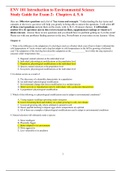Study guide
ENV 101 Introduction to Environmental Science Study Guide for Exam 2: Chapters 4, 5, 6
- Course
- ENV 101
- Institution
- Northern Michigan University
1. What is the difference in the adaptation of a sled dog's (such as a Husky) thick coat of hair to help it withstand the cold temperatures of Arctic winters and a dog that adapts to cold temperatures in the fall by growing a thickened coat? The adaptation of the sled dog best describes adaptation ...
[Show more]



